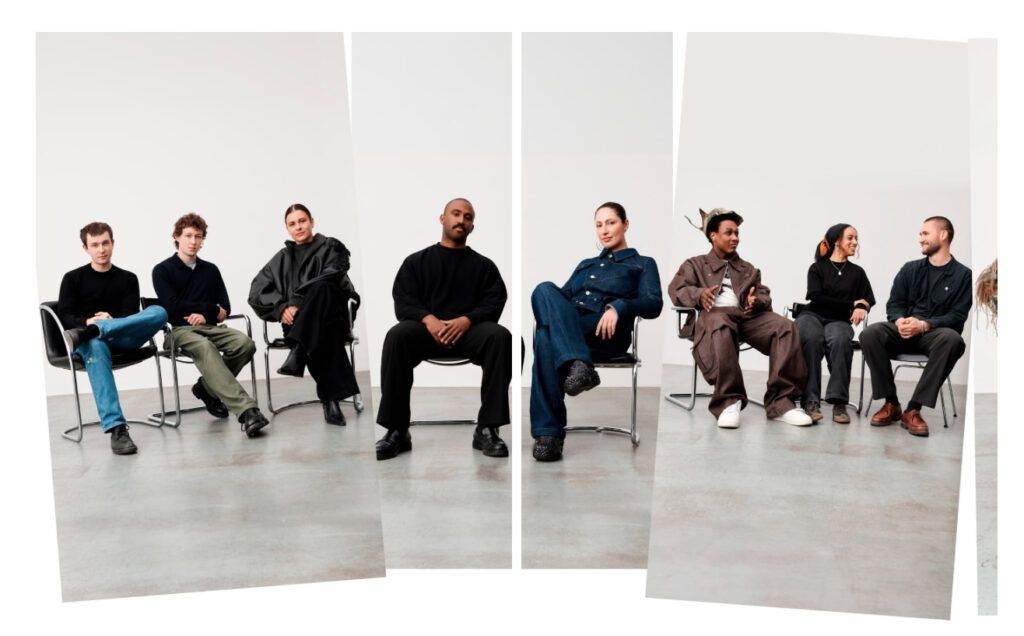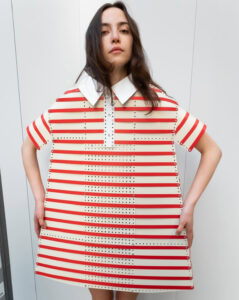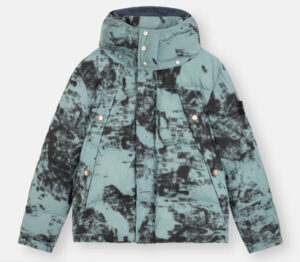Capturing the fashionable zeitgeist, there’s a new group of names-to-know in town, courtesy of the British Fashion Council’s NEWGEN initiative. But this isn’t just a lineup of promising talent—it’s a tectonic shift in the landscape of British fashion. These designers, armed with a philosophy steeped in sustainability, identity, and radical creativity, are dismantling and rebuilding what it means to create clothing in the twenty-first century. NEWGEN, since its inception in 1993, has been synonymous with catapulting future legends into the public eye—Alexander McQueen, Simone Rocha, and Grace Wales Bonner among them. In 2025, the torch is passed once more. And it burns brightly.
At a time when fashion is in urgent dialogue with climate, culture, and commerce, NEWGEN 2025 serves less as a talent incubator and more as a prophecy. These designers do not arrive with polite nods to trends or seasonal pandering. They arrive armed with ideas—big ones. The aesthetic is less about polish and more about presence: fashion as confrontation, as archive, as body politics, as poetry.
The Fabric of Change
The British Fashion Council’s commitment to young designers through NEWGEN has long been lauded, but in 2025, the initiative finds itself not just in a curatorial role, but a custodial one. The climate crisis has made textile production one of the most contentious conversations in the industry. According to a report from the Ellen MacArthur Foundation, the fashion industry is responsible for 10% of global carbon emissions—more than aviation and maritime shipping combined.
In this context, NEWGEN’s class of 2025 is not simply designing—they’re redefining the very parameters of material use. Róisín Pierce, for instance, hailing from Dublin but embraced by the London scene, constructs delicate silhouettes exclusively from zero-waste techniques. Her sculptural white garments—evoking communion dresses, mourning attire, and Irish lace traditions—are entirely handcrafted. There’s no stitch wasted, no concept rushed. In Pierce’s hands, fabric becomes relic and ritual.
Similarly, Aaron Esh—an alum who is returning to NEWGEN after a year of commercial expansion—continues his subversive tailoring with an approach steeped in East London grit and Parisian discipline. His work interrogates masculinity not as a gendered performance, but as an emotional palette. Think asymmetric blazers, slipper-like brogues, and cigarette-slim trousers—all refined and existentially chic. Esh’s work is not flamboyant, but it lingers. Like the smell of cologne on someone who’s left the room.
Narrative Threads: Identity as a Medium
Fashion in 2025 is not only about what’s worn—it’s about what’s said. NEWGEN’s latest cohort doesn’t just design clothes, they narrate diasporas, conjure ancestry, and collapse borders through textile. For designers like Chet Lo, the garment is a page and the body its text. Lo, a Chinese-American designer and Central Saint Martins graduate, fuses Eastern craftsmanship with sci-fi futurism. His signature spiked knitwear has become an Instagram-era iconography—candy-colored, unmissable, and subtly militant in its queering of texture.
But it’s not just aesthetics. Lo’s work challenges Asian stereotypes in fashion, pushing against the flatness with which Asian bodies and narratives are historically rendered. There’s armor in the spikes, softness in the colors, and an undeniable queerness in the tension between them.
Newcomer Johanna Parv, originally from Estonia, centers movement and modularity in her vision of women’s urban wear. Parv designs with the female commuter in mind—cyclists, sprinters, night-walkers. Her garments feature detachable panels, reflective textiles, and harnesses reimagined as couture detailing. This is not activewear; it’s activist-wear. It proposes that clothes should serve the body, not command it.
The Return of Craft, Not Nostalgia
While fashion often trades in nostalgia as shorthand for credibility, NEWGEN’s current stars are interested in memory without mimicry. Conner Ives, the upcycling savant, collects Americana—vintage t-shirts, lace, and deadstock material—and retools them into glamorously oddball confections. Ives doesn’t traffic in irony. His collaged dresses and Y2K silhouettes feel devotional, almost childlike in their sincerity. He crafts mythology from landfill. In Ives’ vision, the detritus of consumerism can be re-stitched into talismans.
Meanwhile, Paolo Carzana has emerged as one of the most compelling storytellers of the group. His process is slow, unmechanized, and almost liturgical. Carzana hand-dyes his garments with natural ingredients—flowers, vegetables, soil—giving his ethereal creations a haunting impermanence. His recent collection, “Imaginary Boys,” fused the spiritual with the political: tunics like vestments, trousers like cocoons, and every model appearing like a lost prophet or wounded angel. Carzana, it seems, isn’t designing for commerce—he’s designing for catharsis.
Systems of Support, or the Lack Thereof
Yet behind this wellspring of creativity lies the reality of instability. Fashion is an industry notorious for glamorizing precarity. The BFC’s NEWGEN program offers crucial infrastructure—funding, mentoring, showcasing at London Fashion Week—but designers remain vulnerable to the caprices of capital. The dream of creative freedom often collides with commercial necessity.
Digital platforms help. Social media acts as a decentralized PR engine. But algorithms favor virality over complexity. Many NEWGEN designers use Instagram less to advertise collections and more as portals into their process. This transparency builds community, but it also invites scrutiny, theft, and burnout.
There are structural problems, too. Brexit has hamstrung international trade and complicated supply chains. London’s high rents and production costs continue to push independent designers to the brink. And while NEWGEN helps provide temporary scaffolding, the long-term sustainability of these brands remains an open question.
What’s needed is a paradigm shift. Not just in aesthetics, but in economics. A fashion industry that doesn’t merely celebrate young designers for their vision, but supports them with permanence: housing grants, international logistics infrastructure, fair labor networks, and equitable production channels.
London’s Role as a Style Laboratory
Despite the headwinds, London continues to function as fashion’s pressure cooker—its aesthetic chaos birthing new languages. The NEWGEN designers don’t “fit” into London Fashion Week so much as bend it around them. Their shows are performance rituals, often taking place in abandoned warehouses, Brutalist car parks, or deconsecrated churches. These are not runways—they’re invocation chambers.
It’s this disobedient energy that continues to define the city’s contribution to global style. Whereas New York delivers polish, Milan offers heritage, and Paris commands myth, London creates friction. And friction, in the hands of NEWGEN’s class of 2025, becomes fuel.
We must not underestimate the influence these designers already exert beyond the island. Their designs are being worn by Rihanna, Rosalía, A$AP Rocky, and Bad Bunny—not as commercial endorsements, but as co-conspirators in visual rebellion. London’s experimental pulse is global now. And it beats through NEWGEN.
Looking Forward: Not a Movement, But a Manifestation
In past eras, fashion moved in distinct movements: minimalism, grunge, normcore, etc. But NEWGEN 2025 resists such simplification. This is not a movement; it’s a manifestation. A constellation of practices that range from maximalist embellishment to stripped-down monastic wear, from acid-colored knitwear to ghostly tailoring. What binds them isn’t look—it’s ethos.
Their work is post-institutional, post-binary, post-exploitative. It’s shaped by economic fragility, ecological collapse, and digital acceleration. And yet it resists despair. There’s optimism here—but not naïveté. A sense that in dressing ourselves, we can undress the systems that bind us.
Impression
Fashion is often accused of being frivolous. But for the designers emerging from NEWGEN’s 2025 cohort, it’s anything but. Their work tackles queerness, cultural heritage, labor ethics, environmental crisis, and gender autonomy. They aren’t designing clothes—they’re designing futures.
And maybe that’s the ultimate purpose of NEWGEN: not to churn out trends, but to cultivate futures worth wearing. In an era of upheaval, fashion remains one of the most intimate tools we have to express, revolt, heal, and imagine. These designers are not just names-to-know. They are names to remember.
Because they’re not just responding to the zeitgeist—they are the ones writing it.
No comments yet.









